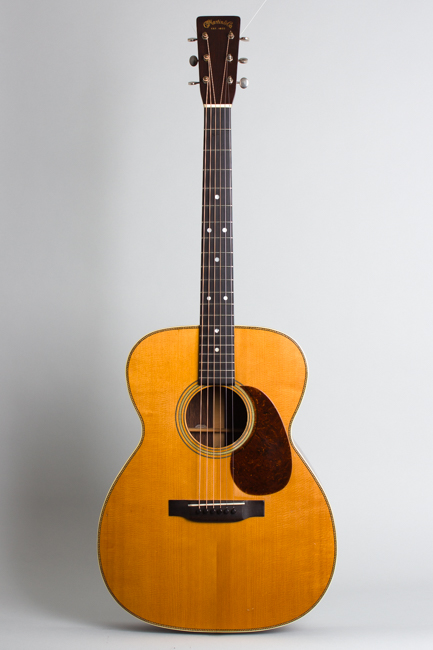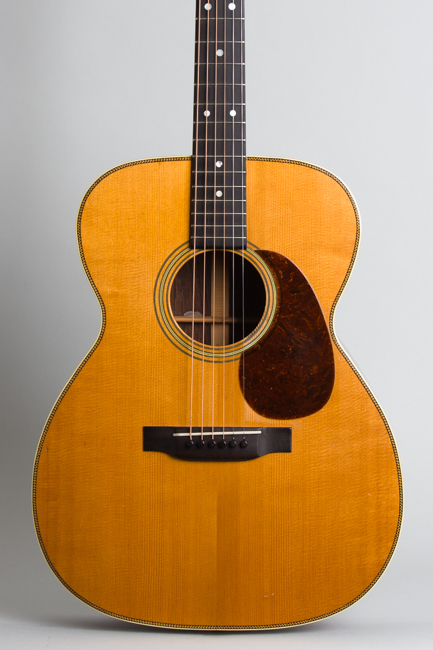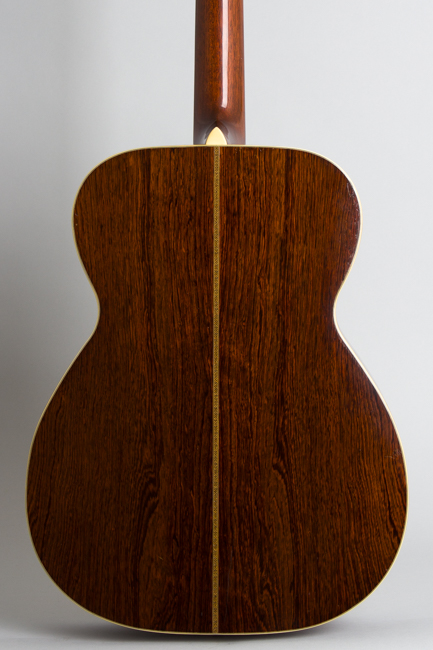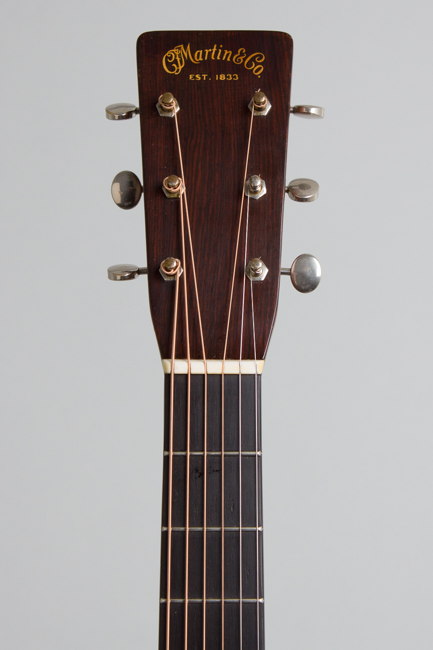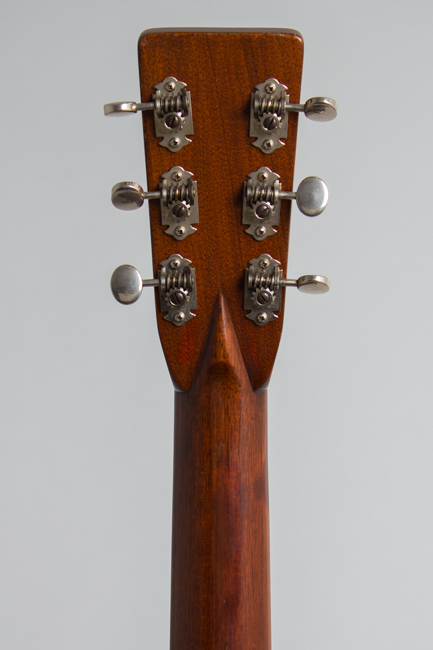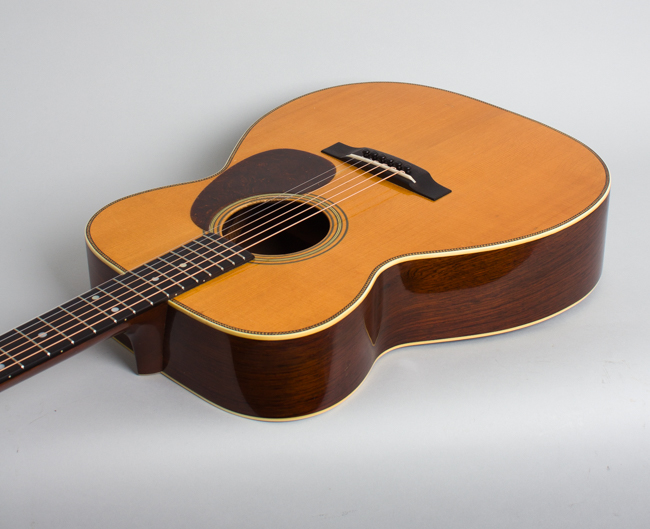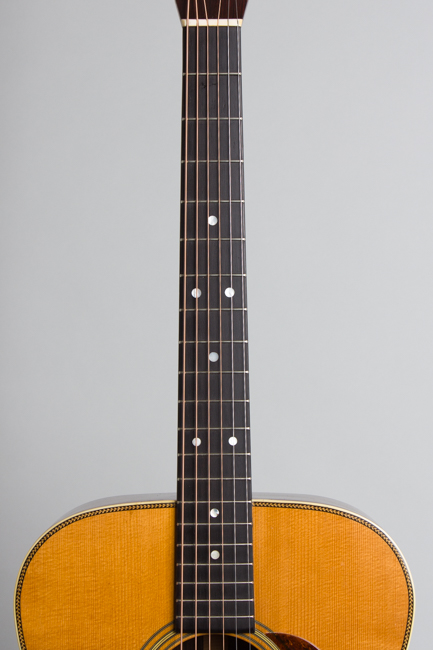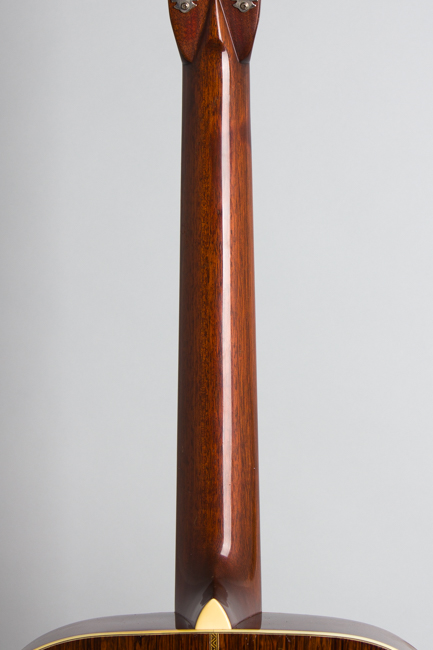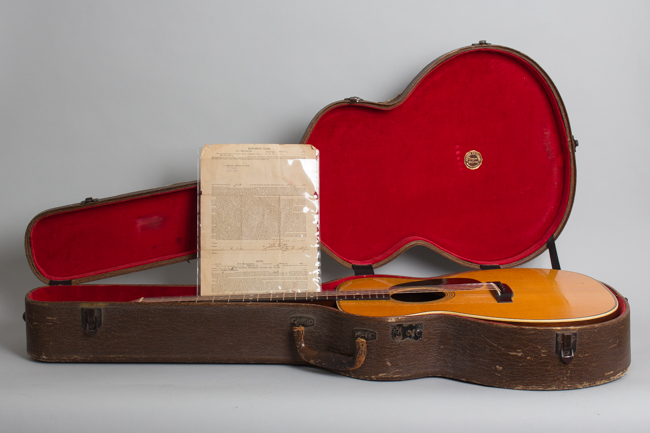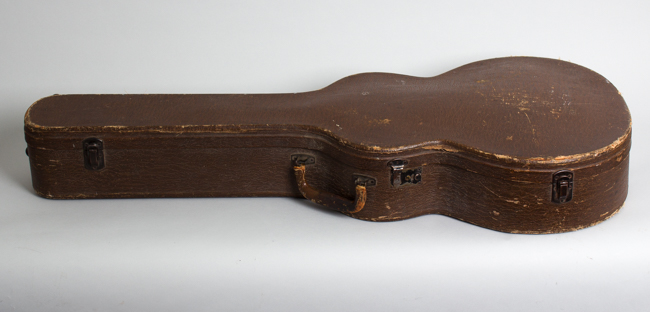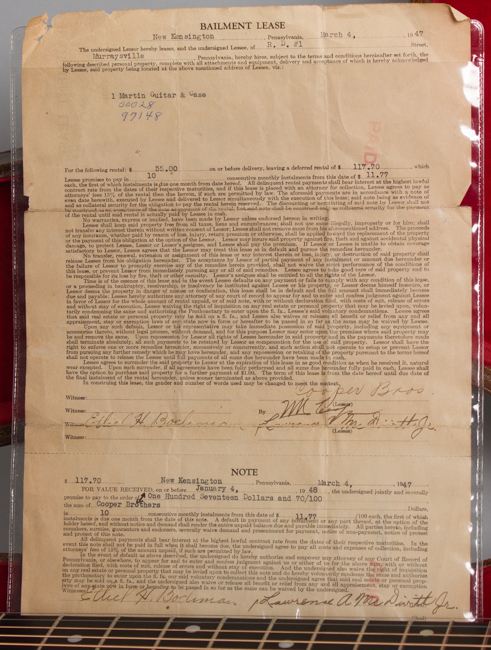C. F. Martin 000-28 Flat Top Acoustic Guitar (1946)
This item has been sold.
Item # 12672
Prices subject to change without notice.
C. F. Martin 000-28 Model Flat Top Acoustic Guitar (1946), made in Nazareth, PA, serial # 97148, natural lacquer finish, Brazilian rosewood back and sides, spruce top; mahogany neck with ebony fingerboard, original brown hard shell case.
This is a truly beautiful postwar Martin 000-28 made in the latter part of 1946; It would have shipped out as the US was shifting back to peacetime footing after years of wartime restrictions. This is one of the best preserved Martins of this period we have seen in a long time, and a spectacular sounding and playing guitar to boot!
The 14 fret "herringbone" 000-28 is to some players the perfect flat-top. The 15" wide narrow-waisted body is just over 1/2" smaller than a Dreadnought so yields a somewhat more focused midrange sound with a less dominant bass. By late 1945 the top is no longer scallop-braced top but is still not as heavily built as later 1950s examples, offering considerable power when pushed combined with sweetness, sparkle, and a singing character even when played softly. The scale is slightly shorter than the earlier 1930s OM model making the action a bit more supple.
This 000 shows transitional period appointments. The back and sides are Brazilian rosewood with some really dramatic figure on the back in particular. The top is straight-grained spruce, bordered with the famous "herringbone" wood trim that defines the Style 28 models and bound with ivory celluloid. "Herringbone" would disappear from Martins for more than a generation in 1947 not long after this guitar was made. The back is triple-bound in celluloid with a zip-zag pattern backstrip. Other features include the long-saddle ebony bridge, multiple celluloid sound hole rings and tortoise celluloid pickguard.
The neck is mahogany with an unbound ebony fingerboard and larger mixed-size pearl dot inlay. The neck is quite a bit thicker than many Martins with a rounded soft "V" profile, noticeably chunkier than many wartime necks. It retains the wartime ebony reinforcement, without the steel T-bar making for a lighter guitar overall. The peghead is faced in Brazilian rosewood with the gold "C.F. Martin & Co." decal at the top. The nut is the traditional 1 11/16" width while the tuners are individual Waverly openbacks more often seen in the early 1940's that were likely leftover stock.
Rosewood 000s from this period are far from common guitars. Only 136 000-28s were produced in 1946, a very small total by modern standards. The list price was officially $127; the original owner of this one lived in rural Pennsylvania and purchased it in March 1947 with a layaway deposit of $55 and 10 monthly installments of $11.77. He obviously took exceptional care of the guitar; this 000-28 is a spectacular survivor! It offers the smooth and powerful sound typical of original 1940s Martins, perfect for styles vintage or contemporary, a fantastic recording guitar. While not absolutely perfectly preserved it is closer than most, and as always an excellent player ready for many more decades.
Overall length is 39 3/4 in. (101 cm.), 15 1/8 in. (38.4 cm.) wide at lower bout, and 4 1/8 in. (10.5 cm.) in depth at side, taken at the end block. Scale length is 24 3/4 in. (629 mm.). Width of nut is 1 11/16 in. (43 mm.).
This lovely Brazilian rosewood 000 shows only light wear and tear for being almost 80 years old, and has had only fairly minimal repair along the way. The original thin lacquer finish overall is for the most part extremely well preserved, showing mostly just some light play wear. There is shallow checking and small nicks and dings to the top, with one small area of pick wear into the wood just off the back edge of the pickguard. The back and sides have some broader light checking and a few dings and scuffs. The only finish alteration is a very light lacquer overspray to the back of neck extending from the heel to the back of the headstock. This looks to have been done a long time ago and is over some old wear in the first position.
The most noticeable repair is a rosewood grain crack to the back above the upper side of center seam marquetry, recently sealed and cleated without added finish. There are no other cracks to the guitar. The ebony bridge appears original and looks to have been slightly lowered and fitted with a newer bone saddle. The guitar has had a very clean neck reset and perfect period correct refret retaining the original bone nut. The original celluloid pickguard and Waverly tuners are still intact. Internally all bracing remains untouched as does the original small maple bridgeplate.
Herringbone Martins of this type often appear heavily used and are increasingly hard to find in anything like this original condition. This stunning survivor shows a few minor scars but is one of the nicest we have seen or heard, still housed in the original HSC with the original layaway bill of sale. This is just a superb herringbone package, a timeless classic that looks stunning but is just worn enough to play and enjoy without trepidation! Overall Excellent Condition.
This is a truly beautiful postwar Martin 000-28 made in the latter part of 1946; It would have shipped out as the US was shifting back to peacetime footing after years of wartime restrictions. This is one of the best preserved Martins of this period we have seen in a long time, and a spectacular sounding and playing guitar to boot!
The 14 fret "herringbone" 000-28 is to some players the perfect flat-top. The 15" wide narrow-waisted body is just over 1/2" smaller than a Dreadnought so yields a somewhat more focused midrange sound with a less dominant bass. By late 1945 the top is no longer scallop-braced top but is still not as heavily built as later 1950s examples, offering considerable power when pushed combined with sweetness, sparkle, and a singing character even when played softly. The scale is slightly shorter than the earlier 1930s OM model making the action a bit more supple.
This 000 shows transitional period appointments. The back and sides are Brazilian rosewood with some really dramatic figure on the back in particular. The top is straight-grained spruce, bordered with the famous "herringbone" wood trim that defines the Style 28 models and bound with ivory celluloid. "Herringbone" would disappear from Martins for more than a generation in 1947 not long after this guitar was made. The back is triple-bound in celluloid with a zip-zag pattern backstrip. Other features include the long-saddle ebony bridge, multiple celluloid sound hole rings and tortoise celluloid pickguard.
The neck is mahogany with an unbound ebony fingerboard and larger mixed-size pearl dot inlay. The neck is quite a bit thicker than many Martins with a rounded soft "V" profile, noticeably chunkier than many wartime necks. It retains the wartime ebony reinforcement, without the steel T-bar making for a lighter guitar overall. The peghead is faced in Brazilian rosewood with the gold "C.F. Martin & Co." decal at the top. The nut is the traditional 1 11/16" width while the tuners are individual Waverly openbacks more often seen in the early 1940's that were likely leftover stock.
Rosewood 000s from this period are far from common guitars. Only 136 000-28s were produced in 1946, a very small total by modern standards. The list price was officially $127; the original owner of this one lived in rural Pennsylvania and purchased it in March 1947 with a layaway deposit of $55 and 10 monthly installments of $11.77. He obviously took exceptional care of the guitar; this 000-28 is a spectacular survivor! It offers the smooth and powerful sound typical of original 1940s Martins, perfect for styles vintage or contemporary, a fantastic recording guitar. While not absolutely perfectly preserved it is closer than most, and as always an excellent player ready for many more decades.
Overall length is 39 3/4 in. (101 cm.), 15 1/8 in. (38.4 cm.) wide at lower bout, and 4 1/8 in. (10.5 cm.) in depth at side, taken at the end block. Scale length is 24 3/4 in. (629 mm.). Width of nut is 1 11/16 in. (43 mm.).
This lovely Brazilian rosewood 000 shows only light wear and tear for being almost 80 years old, and has had only fairly minimal repair along the way. The original thin lacquer finish overall is for the most part extremely well preserved, showing mostly just some light play wear. There is shallow checking and small nicks and dings to the top, with one small area of pick wear into the wood just off the back edge of the pickguard. The back and sides have some broader light checking and a few dings and scuffs. The only finish alteration is a very light lacquer overspray to the back of neck extending from the heel to the back of the headstock. This looks to have been done a long time ago and is over some old wear in the first position.
The most noticeable repair is a rosewood grain crack to the back above the upper side of center seam marquetry, recently sealed and cleated without added finish. There are no other cracks to the guitar. The ebony bridge appears original and looks to have been slightly lowered and fitted with a newer bone saddle. The guitar has had a very clean neck reset and perfect period correct refret retaining the original bone nut. The original celluloid pickguard and Waverly tuners are still intact. Internally all bracing remains untouched as does the original small maple bridgeplate.
Herringbone Martins of this type often appear heavily used and are increasingly hard to find in anything like this original condition. This stunning survivor shows a few minor scars but is one of the nicest we have seen or heard, still housed in the original HSC with the original layaway bill of sale. This is just a superb herringbone package, a timeless classic that looks stunning but is just worn enough to play and enjoy without trepidation! Overall Excellent Condition.
